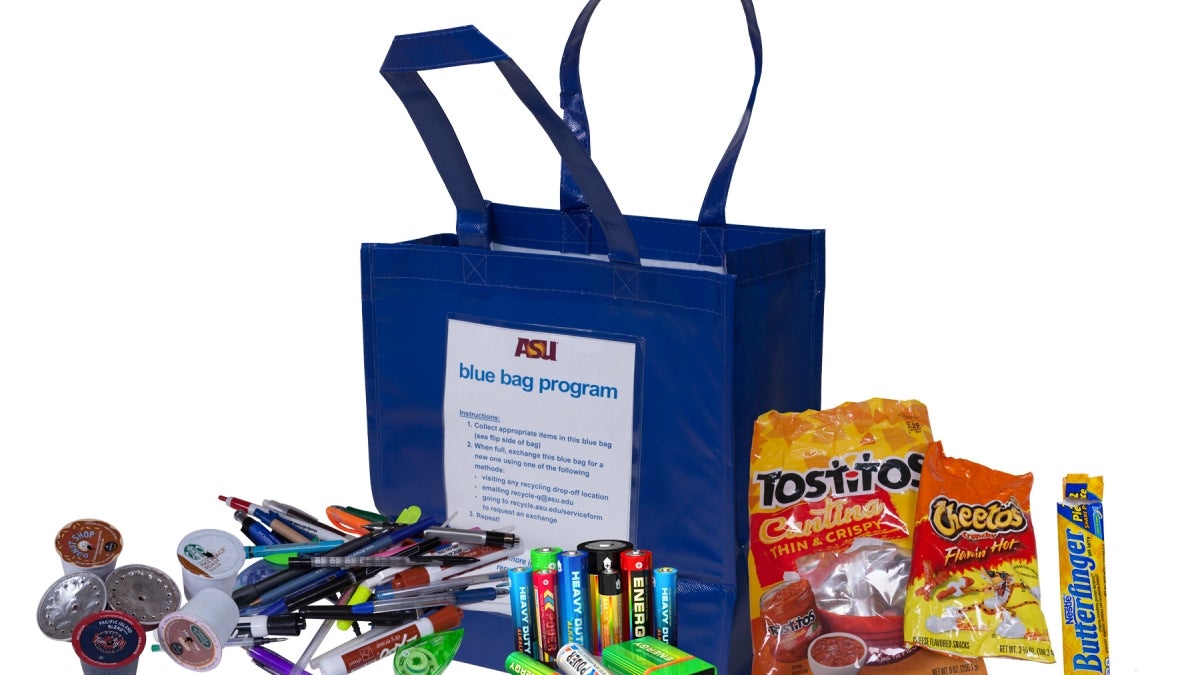ASU blue bag recycling program keeps trash out of landfill

Not sure if your shiny granola bar wrapper belongs in the blue recycle bin, but you don’t want to send it to the landfill?
The perfect way to keep your wrapper from reaching the landfill is to request a blue bag from the ASU Recycling Program team.
“With the ASU community’s support, during 2014, ASU achieved a 26.5 percent waste diversion rate. For instance, we diverted more than 1,200 pounds of polystyrene, which could fill an average-size one-bedroom apartment,” said Alana Levine, ASU Recycling and Solid Waste manager. “Our recycling team believes blue bag use can boost our landfill waste diversion efforts.”
Blue bags are available to offices and departments on the ASU Tempe campus. The bags complement the university’s widespread blue bin commingled recycling program. The following items are blue-bag friendly:
• batteries (dry cell, non-rechargeable)
• coffee pods (one-time use)
• cosmetics containers
• shiny plastic bags
• shiny plastic wrappers
• small eWaste (such as calculators and MP3 players)
• small toner cartridges
• spent pens & markers
• used plastic gift cards
• water filters
“On average, about 350 tons of waste per month collected at the Tempe campus goes to the landfill,” said Lucas Mariacher, ASU Recycling Program technician. “We are taking recycling to a whole new level with the blue bag program. Before program launch, the majority of items that are accepted in blue bins were being landfilled.”
Blue bag genesis
ASU’s Recycling team developed the blue bag program from employee demand and is hoping to boost use among the ASU community. The team so far has placed 275 blue bags in 52 buildings on the Tempe campus since January. Bags are provided free of charge.
The program also can accept new materials based on demand.
“For example, if university employees were generating a ton of toothbrushes, we could add the brushes to the list of acceptable blue bag items,” Mariacher said.
It’s Mariacher’s hope that the blue bag program can expand to the ASU Downtown Phoenix, Polytechnic, and West campuses – including the Thunderbird School – in the fall 2015 semester.
A wrapper’s journey
Any student worker, faculty or staff member on the Tempe campus can request as many bags as they would like to place in their work areas.
There are two blue bag sizes. A one-and-a-half-gallon size is ideal for an individual desk or in a cubicle. A larger, five-and-a-half-gallon blue bag is appropriate for larger common areas such as kitchens and break rooms.
Disposable coffee pods are considered “wet” items and should be bagged separately and then placed in the blue bags before pickup by the Recycling team.
Dry cell batteries also require separate bagging. Recycling team members suggest placing batteries in old sandwich baggies that are free from food or other debris. If baggies are not available, plastic grocery bags are acceptable for both spent coffee pods and battery disposal.
Levine noted a partnership with ASU Environmental Health and Safety that ensures batteries collected in blue bags are safely processed to reclaim recyclable metals.
Once blue bags are full, users should email the Recycling team to arrange pickup. The team usually can empty the bags within a few business days’ following a pick-up request. The team is in the process of designing new weekly pick-up routes due to the abundance of materials being collected.
When the blue bags collection is complete, the waste is sorted by hand. Some blue bag items are shipped to TerraCycle. The New Jersey-based company receives products and packaging that is problematic to recycle from 22 countries around the globe. The company repurposes recycled items into new products from everything to soap dishes to totes and even recycle bins.
Blue bags benefit zero waste
ASU community members who use the blue bag recycling program help the university’s zero waste goals. ASU defines zero solid waste as a 90 percent reduction in waste sent to the landfill from current business-as-usual status.
To achieve zero waste, ASU encourages diversion and aversion tactics. Waste is averted through reduced consumption and diverted from the landfill through recycling, composting, and reusing or repurposing.
“It is an all-hands approach to attain ASU’s zero waste goals,” Mariacher said. “We need everyone to recycle as much as possible. Including blue bags in your recycling routine is a small effort that affects larger change.”
Sun Devils are encouraged to contact the Recycling team with comments and ideas about expanding the blue bag program via email.